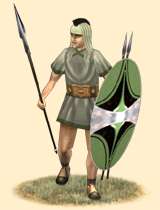Iberi Milites (Iberian Light Spearmen)
 |
Weapons | Defence | Mental | ||||||
|---|---|---|---|---|---|---|---|---|---|
| Primary | Secondary | Armour: | 4 | Morale: | 9 | ||||
| Type: | spear | spear | Shield: | 3 | Discipline: | normal | |||
| Attack: | 5 | 12 | Skill: | 9 | Training: | trained | |||
| Charge: | 4 | 4 | Recruitment | Other | |||||
| Lethality: | 1 | 0.13 | Soldiers: | 60 | Hit Points: | 1 | |||
| Range: | 45 | 0 | Cost: | 1041 | Mass: | 1.05 | |||
| Ammo: | 2 | 0 | Upkeep: | 260 | |||||
| Turns: | 1 | ||||||||

Iberi Milites are a reliable levied militia. Fast and able to pepper the enemy with javelins before charging with their spears, they can be relied to beef up Iberian armies whenever necessity of men is paramount. Although having advantage fighting against cavalry, they can also hold their own against enemy light troops.
Expert at Hiding in Woods
Can Hide in Long Grass
Sapping Ability
These men are occasional warriors that are levied when there is dire need for it. Recruited from all professions of Iberian society, they form a surprisingly reliable and versatile militia. As many warriors in Iberia, they use the usual combination of javelin + spear to fight. Although ill-equipped light spearmen, as their only protection is given by their sinew helms and their traditional large oval shields, their skirmishing abilities and speed makes them a nuisance in many situations if used properly. Although not as reliable as more permanent or experienced warriors like Caetratii or Scutarii, they are handy to reinforce the line or when springing tactical ambushes on enemy units. Even though they are mostly untrained, in accordance with most men in the Iberian peninsula they are no strangers to the disputes among tribes and are on a much higher level of skill and morale than other levied troops.
Historically, the militias were mostly organized among the southern Iberians as a way to respond to sudden unexpected pillage incursions of other tribes, that came mostly from the poorer northern, mountainous regions of Iberia. This permanent state of alert throughout the decades creates harder, higher skilled men and, even if only "occasional" warriors, they were known to have far greater resilience in battle than expected for levy infantry.
Centuries of feuding among the Iberian tribes hardened the people in such a way that there was no shortage of tough, determined and cunning warriors. Iberians used varied weapons, shields and armour, differing according to region, wealth, specific battlefield tasks and personal preference - most swords ("falcatas" and "gladius hispanniensis") were custom built to suit the arm length, weight and strength of it's owner. Even though Iberian tactics were generally constant and specific, they were also unpredictable and very effective when properly used. The Iberians' ability to hide, while keeping their enemy under close watch, before performing coordinated attacks followed by swift retreats, allowed them to surprise enemies when least expected. These Iberian hit and run tactics were called by the Romans "concursare", and sometimes described as "simple absence of tactics". It is known, however, that to perform these coordinated attacks and retreats, across an entire army, in simultaneous different areas, needed an impressive amount of organization and signaling that was probably performed through the use of commonly found rounded ceramic horns. Although the many tribes that populated Iberia never became united under a single ruler before the Roman invasions, several temporary alliances against foreign enemies were known. These alliances, linked to the Iberians' great determination to remain independent of any foreign power, constituted a unenviable obstacle that put Carthage and Rome at check for more than a century.